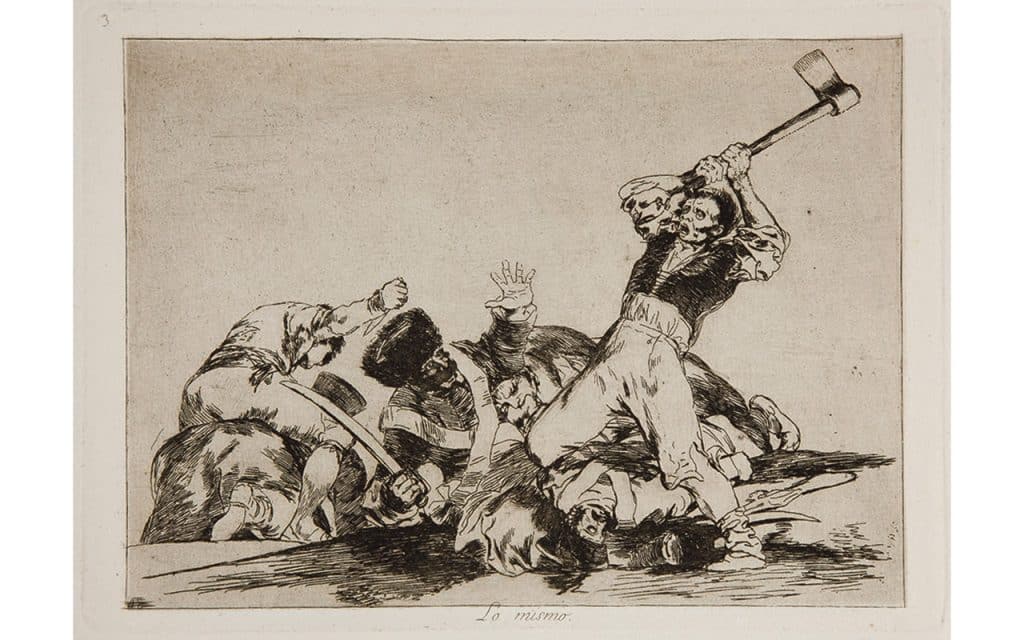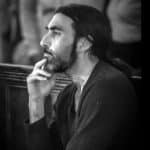
A living line, trembling with energy. The feeling which charges the hand: a poignant burst, guiding the etching needle, twisting, erupting, flicking and flowing, etching death into a copper plate. Francisco Goya’s series of etchings, ‘The Disasters of War’ (1810-1820), is an arguably unequaled record of cruelty, in the medium of print. Even today, with the media’s descriptions and visuals of atrocities in Ukraine and Gaza, Goya’s imagery stands out. It also resonates with the present, reminds us that, when it comes to war, things do not fundamentally change: the litany of destruction, rape, pillage, torture, execution, mass burial, repression and famine was as true for Goya in the 19th century, as it is for people in Gaza and Ukraine in the 21st.
The most fundamental difference between the periods is, of course, technology, and the rise of journalism as a profession. In 1808, with Napoleon at the gates of Spain, there were no reporters with flashing cameras, no film crews tracking cannon fire. Instead, there were artists. Following the siege of Zaragoza by Napoleon’s armies, field marshal, José de Palafox summoned a number of painters, including Goya, to bear witness to the devastated city and the resilience of its inhabitants.
Goya’s response, over the ensuing years, was an unprecedented series of 85 etchings, which look unflinchingly at the horrors of war. The series stood out even then, as Goya, unlike the majority, did not romanticise or glorify the struggle against Napoleon, nor did he look away from the ensuing repression by the Spanish monarchy. His sole guide was truth itself, in all its stark, satirical, and sarcastic nakedness. Upon this dark journey, however, truth was also given up for dead, as articulated in print No. 79, ‘Truth has Died’. It is a powerful narrative, the death of truth, and resonates today as critically as at any other time in history.
When governments propagate large scale falsehoods, such as Israel’s denial that there is famine in Gaza, Russia’s denial that Ukraine is a nation, or the Trump Administration’s insistence that vaccines are bad and climate change, a hoax, then whole nations of people are pressured to abandon the truth. And when that is gone there is only propaganda and dominion. The truth, at this point, becomes dangerous; it certainly was for Goya, who chose not to publish ‘The Disasters of War’ in his own lifetime.
There is a paradox in Goya’s ‘Truth has Died,’ however, for in giving life to the image, he stands for that which he proclaims allegorically dead. This can be said for the entire Disasters of War series: through interrogating the terrors of violence and hunger, he paradoxically stands for life and abundance. His mastery of line and composition, his fidelity to what he sees, the feeling with which he describes every cluster of bodies, breathes with energy and life. That is the poignancy of any great work, which deals with a devastating truth. How something can be both great and horrific, how it can be both timeless art and a mirror of its time; the paradox, the poignancy gives it all the more weight, a magnetising, yet devastating gravity.
Bodies dismembered, mutilated, garrotted; bodies stripped, abandoned, thrown into a pit; men impaled, shot, castrated and hung; women pleading with would-be rapists, women knifing soldiers in the back; townsfolk lynching captured soldiers, soldiers with bayonets raised, to execute townsfolk.
Goya is as unrelenting in his portrayal, as he is classical in his delivery. Throughout the series one becomes aware of the influence of Rembrandt, Rubens, Piranesi, Caravaggio. Echoes of Rubens’ dramatic clusters of bodies, of Rembrandt’s brilliant chiaroscuro, of Piranesi’s mysterious arches, of Caravaggio’s violent, tilting planes, abound in the Disasters of War. What unfolds is as much a profound act of witness as a master class in the art of composition.
A similar endeavour today might be seen as redundant. Thousands of images roll across our screens, given perhaps only a cursory look. Images of famine and mutilation, particularly involving children, are the most difficult to view. A disparity between our screens and reality allows us to scroll on; understandably we would rather not look. Certainly for Goya, the Disasters of War was not a commercial enterprise; who, indeed, would want such images on their wall? They would find their place, ultimately, in a state institution, the Royal Academy of Fine Arts of San Fernando, to become the defining record of the Peninsular War, and beyond that, a timeless indictment against human violence.
Art, it must be said, changes nothing, as the cycle of power and dominion, rolls on. And yet it changes everything; for Goya’s act is an act of transmission: of empathy, irony and rage; of a living line, a trembling impression, a human trace; of a compendium of human knowledge, of a fire storm of courage.
Centuries on, Goya’s etchings still enliven and provoke, challenging artists today to be brave, to commit truth to canvas, etching plate, memory chip. It is part of the call of art, to rise to the moment; to answer the question posed by T.S. Eliot: “do I dare disturb the universe?”



